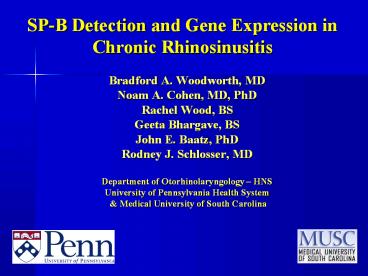SP-B Detection and Gene Expression in Chronic Rhinosinusitis - PowerPoint PPT Presentation
1 / 19
Title:
SP-B Detection and Gene Expression in Chronic Rhinosinusitis
Description:
SP-B facilitates properties of surfactant and is also shown to have direct anti ... Extremely hydrophobic protein with multiple post-translational modifications ... – PowerPoint PPT presentation
Number of Views:56
Avg rating:3.0/5.0
Title: SP-B Detection and Gene Expression in Chronic Rhinosinusitis
1
SP-B Detection and Gene Expression in Chronic
Rhinosinusitis
- Bradford A. Woodworth, MD
- Noam A. Cohen, MD, PhD
- Rachel Wood, BS
- Geeta Bhargave, BS
- John E. Baatz, PhD
- Rodney J. Schlosser, MD
- Department of Otorhinolaryngology HNS
- University of Pennsylvania Health System
- Medical University of South Carolina
2
Grant support
- Cystic Fibrosis Foundation
3
Surfactant
- Secreted in lungs by type II pneumocytes and
Clara cells - Phospholipids (lamellar bodies) 80-90
- Used for premature infants
- Decrease surface tension
- Decrease viscosity of mucus
- Proteins 10-15
- SP B and C hydrophobic, PL processing
trafficking, anti-microbial properties - SP A and D hydrophilic, immune functions
4
Surfactant in Airway Mucus
- Coats surface of gel layer to reduce surface
tension - Decreases the viscosity of mucus
- Increases mucociliary clearance
- SP-B facilitates properties of surfactant and is
also shown to have direct anti-microbial
properties
5
SP-B
- Extremely hydrophobic protein with multiple
post-translational modifications - SP-A and D found at mucosal and epithelial
surfaces throughout the body - SP-B originally thought to be limited to the
lungs - Recent studies show expression in the Eustachian
tube mucosa
6
SP-B in Pulmonary Surfactant
SP-B
LB
Tubular Myelin
What role does surfactant play in the sinuses?
7
Prior Studies
- Phospholipid lamellar bodies in sinonasal
epithelium
8
Prior Studies
- Hydrophilic surfactant proteins A and D in sinus
mucosa - Localize to epithelium and submucosal glandular
elements - Upregulated in cystic fibrosis CRS mucosa
Is there a role for SP-B?
9
Hypothesis
- SP-B is present in sinonasal mucosa and
expression is altered in several types of CRS
when compared to healthy controls.
10
Methods
- Sinus mucosal biopsies
- Allergic Fungal Rhinosinusitis (n7)
- Cystic Fibrosis (n 4)
- Non-atopic CRS with nasal polyps (n5)
- Healthy controls (n5)
- Quantitative RT-PCR, immunoblot,
immunohistochemistry
11
Methods Cycle threshold (Ct)
12
Methods Cycle threshold (Ct)
- Delta Ct (?Ct) - Ct for mRNA subtracted from Ct
of internal control (18s rRNA). - Eliminates effect of differences in sample
concentration on Ct. - Individual ?Ct values of each subtype of CRS are
compared to the healthy control tissue
13
SP-B Quantitative RT-PCR
p 0.004
167-fold elevation in CF patients compared to
healthy controls
14
Detection of SP-B Proprotein
42 kDa
Detection of the proprotein and intermediate
forms confirms translated product
- Where is the protein produced and secreted?
15
Immunofluorescence
Sinus Epithelium
Submucosal Glands
SP-B expression green, Nuclear stain in blue
SP-B localizes to the epithelium and submucosal
glands
16
Discussion
- SP-B was significantly upregulated in CF CRS
mucosa - Pseudomonas produces proteases known to degrade
SPs (Malloy et al). - SP-B upregulated in response to degradation of
SP-B and surfactant by Pseudomonas. - Alternatively, increased submucosal glands in CF
mucosa contribute more mRNA transcripts to sample
17
Conclusion
- SP-B is upregulated in cystic fibrosis CRS and is
produced by the epithelium and submucosal glands
of the sinonasal cavities. - Further studies indicated to investigate the role
that SP-B and surfactant have in CRS.
18
Future directions
- Anti-microbial properties of SP-B as a potential
therapy for infectious CRS - In vivo and in vitro models
- Further delineation of protein expression and
specific localization with immunoelectron
microscopy
19
Thank You































